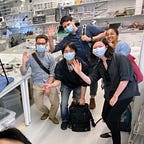Inspired by Thomas Thwaites’ The Toaster Project, we set out to teardown and rebuild the Fitbit’s physical device and digital experience with our design perspectives.
The Devices
Each team member focused on a specific Fitbit model to investigate the variety of offerings from Fitbit from an inclusive perspective. Sandhini had the popular standard Fitbit model, Inspire 2. Shin worked with the kids model, Ace 3. Jorge took the advanced fitness and activity tracker model, Charge 5. Roxanne worked with the luxury and fashion model, Luxe.
The Structure
Phase 0 — Wearing Fitbit
Before dissecting and reimagining our devices, we started by creating Fitbit accounts and logging our experiences, reactions, frictions, and surprises while wearing our devices.
Over the next three phases the team split into two to focus on the data platform and the physical device, respectively. Sandhini and Shin investigated the Fitbit data platform, considering the website app, public APIs, tech stack, or other integration which enables Fitbit to collect, process, and store data. Roxanne and Jorge were tasked with deconstructing each of their physical devices, considering the components comprising the assembly, the manufacturing of various parts, and the electronics that corresponded to critical device functions.
The next phase approached the product system from a new perspective. Could we build these physical devices and digital experiences ourselves as a startup? Using an assumption that our startup is ordering 100,000 units, all of which are pre-sold and will be in-use simultaneously, how might we reconstruct digital experiences and physical assemblies? The digital and physical teams set off to find estimations and starting points to guide our fictional startup in developing a device ecosystem not only replicable to Fitbit, but considerate of sustainability, ethics and regulation, and cybersecurity.
Our final phase was to reconstruct our hypothetical startup product prototype, with different baseline assumptions than Fitbit. Much like Thomas Thwaites’ created rules to build his toaster, our teams similarly set rules or goals to construct our version of the Fitbit wearable tracker, such as minimal cloud data storage or better integration with the body.
Our progress resulted in approximations and barely considered betas, but in the short amount of time we were able to hone our design heuristics and reimagine the technical elements of a quantified self experience.
Details of the Fitbit redesign will be published in future blog posts.
